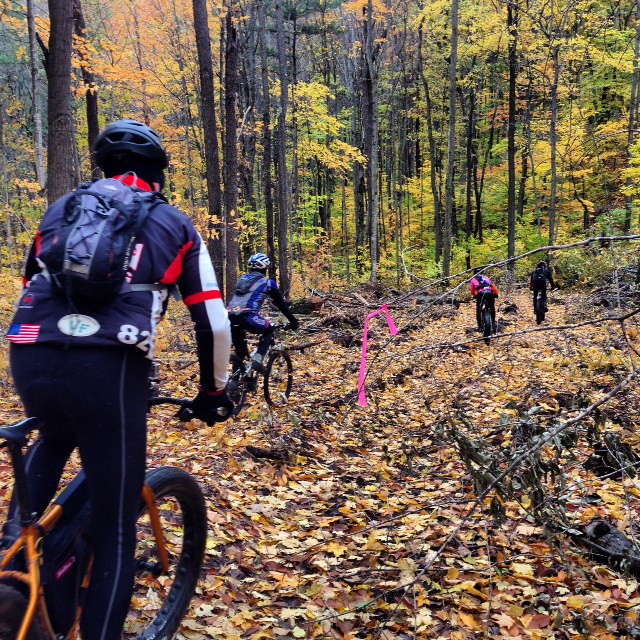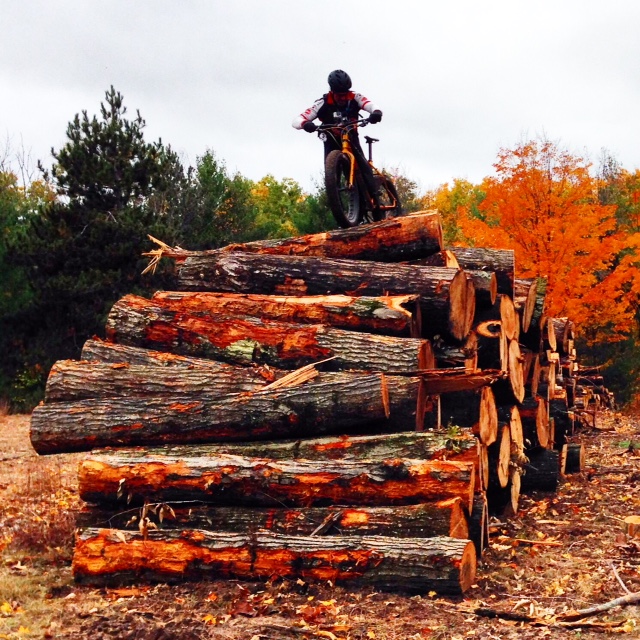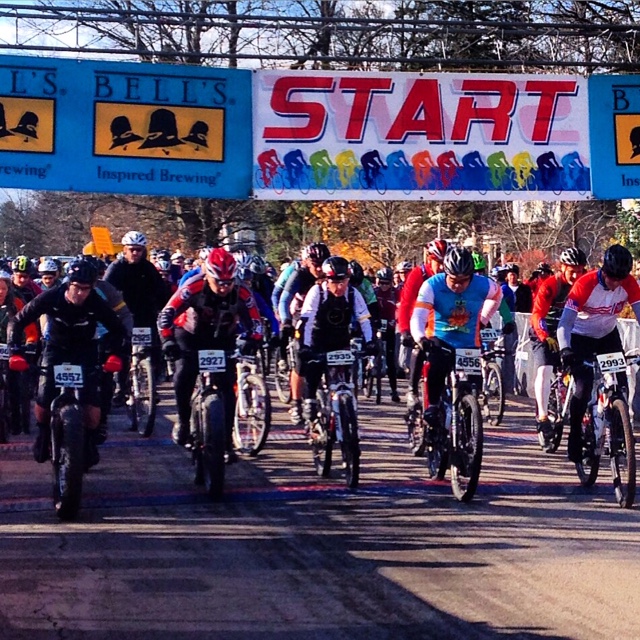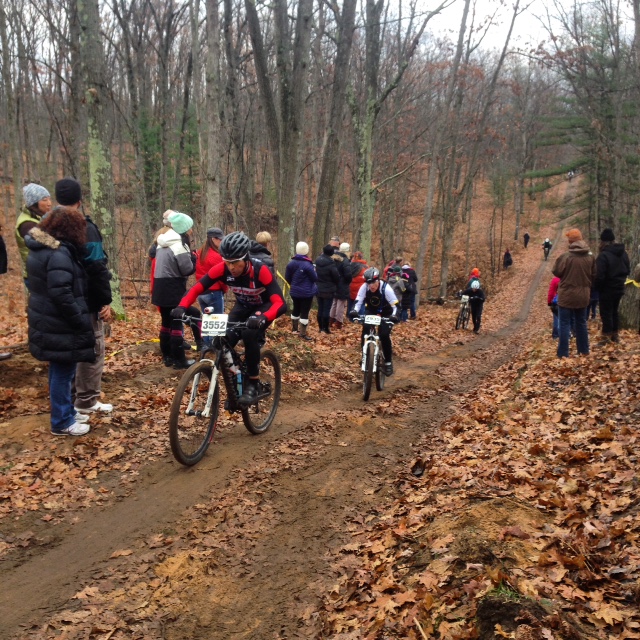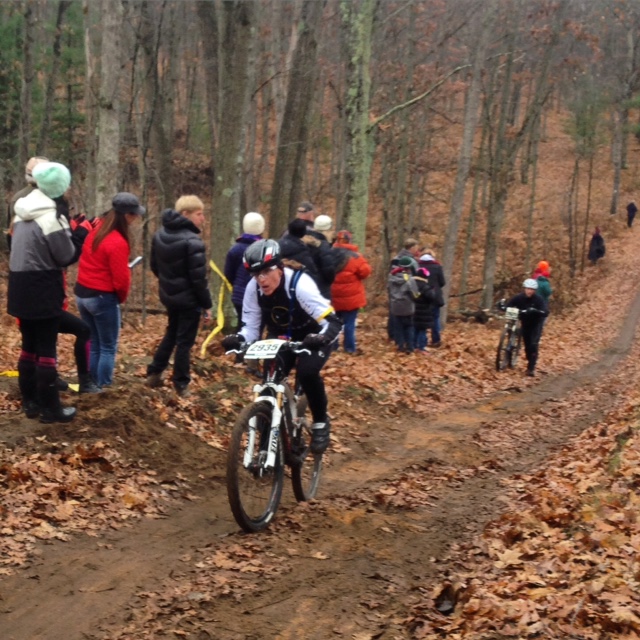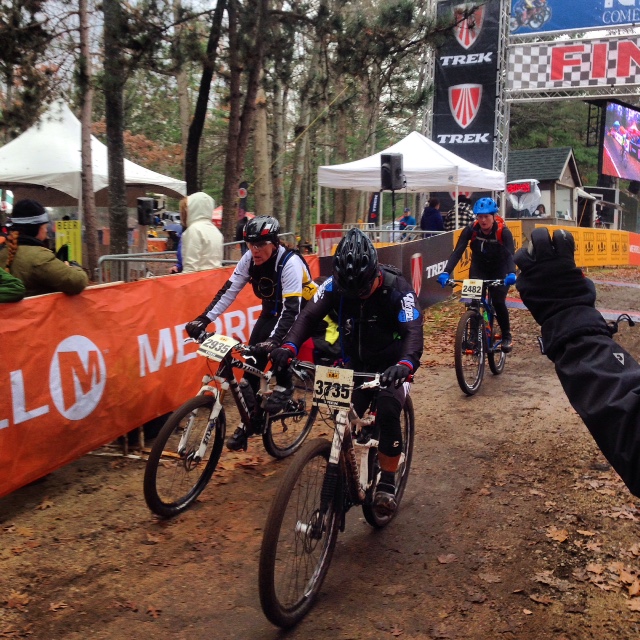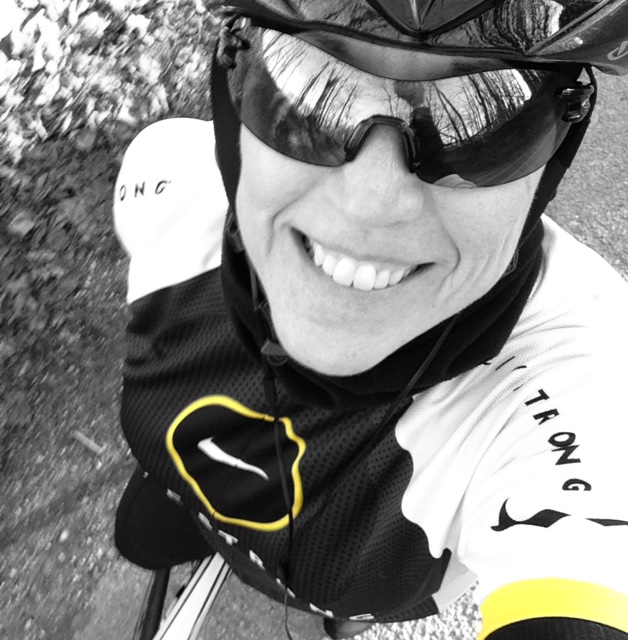The Iceman Cometh Challenge is a point to point MTB race held traditionally each year on the first Saturday of November. The race starts in downtown Kalkaska, Michigan and finishes thirty miles later on the eastern edge of Traverse City. The course consists primarily of dirt roads, two track jeep roads, abandoned railroad beds, logging roads, and the world famous Vasa Nordic ski trail. It crosses only one paved road (Williamsburg Road at mile 17) as it winds through the Pere Marquette State Forest in Northern Lower Michigan. This is a huge race, with approximately 4,000-5,000 riders of all skill levels racing each year, as well as pro riders. Snow during the race is common, and temperatures are typically in the 30’s.
Iceman 2014 was my first MTB race. At the time I was a diehard experienced roadie with no interest in mountain biking, and I also had no clue what I was in for. I had only recently started riding a fat bike the previous winter, and I didn’t own a MTB at the time. However, we had a group of friends who convinced me that my endurance and fitness level would make this race a piece of cake in the fat bike class.
Several weeks prior to the race, five of us went to Kalkaska to do a pre-ride of the course because I had insisted that I needed to know what I was in for. Northern Michigan has much harsher weather than Indiana, and it was already in the 40’s in mid-October. It drizzled rain all morning as we headed north to do a pre-ride on October 18th.
We parked in the parking lot in downtown Kalkaska, which was yards from where the start of the race would be. As we unloaded the bikes, the steady drizzle had stopped, and it had settled into a cold and gloomy day. Kalkaska is a not a big city, and I wondered what it would be like on race day with over 5,000 riders and their families crammed into this small town.
We started riding on pavement and proceeded several blocks to an open field, where we soon found ourselves on a grassy doubletrack that ran along a fence line. The start seemed precarious to me, as I couldn’t imagine a wave of 100+ riders vying for position on this narrow course, that soon turned into a dirt track that ran into the woods. Since there are thousands of riders, there are usually about 50 waves of 100 riders or so leaving the starting line every 3 minutes. That first year I had been assigned to a relatively early wave, number 14, because I had logged the most training miles in the month of October for women in the Ice Society. The Ice Society is found on the Iceman webpage and connects to your Strava account and gives you points for distance ridden and elevation. I was thankful for that, as I was hoping I would be riding with more skilled riders. Wave assignments are usually given based on your last year’s performance. For those who have never raced before, like me, I had earned a higher wave assignment based on my training the month before the race. (I also won a Galaxy 500 Note Tablet!)
As we rode through the forest with a very heavy leaf cover, I knew almost immediately that riding a 33 pound fat bike for 30 miles through this terrain was not going to be easy. It took a great deal of effort pushing the big tires through the mud, leaves, and sand. Plus, this race included over 2,000 feet of climbing.
The ride was beautiful as we rode through the forest, but it turned sketchy at about mile 10 when the sandy hills began. I crashed as I tried to descend one of these hills. Thankfully I wasn’t hurt because it was like landing on a sandy beach. This hill quickly turned onto a logging road with foot deep, muddy ruts that had been left by the logging trucks. The mud was so thick that this road was completely unrideable in sections. We paused to take pictures on the logs in a clearing while James assured me that the course would be completely cleared and fixed by the week of the race.
The pre-ride was fun and the scenery was beautiful, however, I was completely exhausted. Still, I was happy that I had ridden it because I now knew what to expect on race day. Or so I thought…
The day of the race, November 8, 2014, arrived quickly. The week prior to the race it had rained almost every day. Race day was no different. It was just above freezing with a constant drizzle as we pulled into the school parking lot in Kalkaska to unload our bikes. The small town was jam packed with cars, spectators, and racers as we rode to the starting line. Marc was in an earlier wave, and I was left to huddle under a tent with dozens of other riders while waiting for my wave to start. I was shaking in the cold and I just wanted to move. My wave started 15 minutes after Marc, and soon I was off. I was surrounded by MTBs that quickly passed me as we headed into the forest. I noticed immediately that this was nothing like the pre-ride. Mud was 6 inches deep in spots and my chain quickly became so coated with mud that shifting was difficult. My hands were freezing because I had made the mistake of wearing my waterproof scuba gloves. They were waterproof, but they weren’t very insulated.
Soon we came across the logging roads. There were ruts in the center of the road that were now several feet deep. Literally hundreds of riders were walking their bikes either through the center of the ruts or along the road edges. This was much worse than the pre-ride. My feet sank ankle deep in mud as I tried to drag my 33 pound bike through the mud and then up a hill. This was exhausting. Marc had called me on my phone while I was stopped earlier and had said his chain was broken and the repair he attempted didn’t hold, so he was finished. He would end up waiting hours for a rescue in the cold rain. When he was picked up he was not allowed to sit in the rescuer’s truck because he was muddy, so he shivered in the truck bed while they drove to the race finish.
After we passed the logging roads, my gears had become so caked with mud that I could no longer shift. All along the course I saw riders down with flat tires, broken chains, and other technical problems. One rider was awaiting a medical rescue with some friends as it looked like he might have a broken leg.
The singletrack through the forest was a nightmare. There was a traffic jam of riders, and each time I would hit a muddy rut and get knocked off the bike I’d have to stand and wait for a break in traffic to get back on the track. Getting enough traction in the mud to get moving again was difficult, and it was also hard dodging riders in front of me who would wipe out in the mud. Throughout the race I ate ShotBlok energy chews that were in a bag on my handlebars. There was no way to eat these without also eating gritty sand and mud. Every part of me and the bike was coated. I had long ditched my glasses because I couldn’t see, and mud was getting spattered in my eyes.
At about 5K before the finish line (there are red markers on trees throughout the course) my chain kinked and I could no longer pedal. A man at the top of the hill told me the chain was probably destroyed. His chain was broken, but he said he had come too far to quit and he intended to finish by coasting the downhills and walking the rest. I managed to get the kink out and get back on the bike, when I realized I had run out of water. By this time I had been on the course over 4 hours, which is not something I had intended. I was cold and exhausted, and now I was thirsty too. Shortly thereafter, I noticed that the rain had turned into snow flurries.
After what seemed like an eternity in the forest, I heard cheers and saw an orange plastic snow fence lining what I believed to be the final sprint. Relief swept over me as I thought I must be yards away from the finish line. I was wrong! The track turned away from the crowd and back into the woods. I thought this false finish was unnecessarily cruel. As we came back out of the woods along the orange fence lined with a cheering crowd ringing cow bells, the track headed downhill through a tunnel. At this point I had no idea where the finish line was, until I came up through the tunnel and saw the banner. The race photographer snapped a very unflattering picture of me as I approached the finish line that I both love and hate. I hate it because it is not a pretty picture, but I love it because the picture says it all. I was covered from head to toe in mud, and I even had mud in my lips and teeth. The race was agony but I had made it. I finished at a slow 4:21:53, but I somehow managed to finish 7th in the women’s fat bike class. Overall, because of the terrible race conditions, only 4,013 riders finished out of the approximately 5,400 that were registered. When we met up briefly with our friends Kelly and Jeff after the race, I told them my race time and Kelly gave me a surprised look and said “You finished?!” I still tease him about his apparent lack of faith in me!
Registration for Iceman usually opens in March and historically sells out within days. Registration opened in March for Iceman 2015 and Marc was adamant that we were not going to do this race again. Marc wasn’t happy with the way his rescue was handled, and he wasn’t pleased that registration had gone up to $100, yet race sponsors offer nothing in return. Most races have fees under $50, and they offer a free t-shirt of the event, a meal, or a memento such as a race water bottle. Despite the high entry fee, Iceman offers none of these things. Bags given on race day contain advertisement pamphlets and a small donation from a sponsor, such as a bite sized energy bar. I agreed that we shouldn’t do it again because of the high entry fee, and because of the terrible course conditions. I knew the race sponsors had no control over the weather, however, I felt the course should have been re-routed around the impassable logging roads. Apparently many people agreed, because by October, Iceman had still not sold out.
About a month before the race, our friend Jeff said he had rented a condo in Traverse city that he wanted us to share with his brother Greg and wife Amber, and he repeatedly asked us to give Iceman another try. So I agreed and entered in the MTB class in my age group. I had gotten a Trek Top Fuel MTB that spring, and I was curious as to how I would do on a different bike. Marc said he would tag along and be a photographer and shuttle us to our car, but he wouldn’t race. I began to look forward to the race, because I was curious how I could perform in better racing conditions on a bike weighing 14 pounds less.
The week before the race was dry in Kalkaska, and I was told that a dry course would make for a very fast race. I decided that finishing the race in under 3 hours was a lofty goal for me, and that is what I was going to try to do.
The day of the race, November 7, 2015, came quickly. It was just above 30 degrees on race day, but it was dry, and the sun had made an appearance. I was to be in wave 25 of 49 waves based on last year’s performance. I decided to set myself at the front of the wave and stay with the lead group for as long as I could to avoid having to dodge riders. I am front and center in this photo, tag number 2935.
The race announcer began counting down, and soon we were off. Within seconds I knew this race was going to be much different than last year. I had no trouble staying with the lead group as we rode through town on pavement to get to the grassy field that would lead us to the woods. When we hit the dirt, I could see that the course was hard packed dirt and sand, and it was very fast! I kept looking at my Garmin and marveled that I was going 18 mph through the woods. It was this way for miles, and I remember thinking that I may possibly finish the race in 2 1/2 hours. Soon after I had this thought I looked up and saw a sign that said “sand” that was warning riders of a deep sand pit ahead. There were riders in front of me and I couldn’t see a way around it. so I jumped off the bike with the other riders, ran through the sand, then got back on my bike.
Soon we approached a very small sandy hill that I should have been able to easily spin up, however, there were so many riders ahead of me that I couldn’t go fast enough to get the necessary traction. I had to walk up this hill because of it, and I wasn’t happy because this wasn’t a hill that anyone should have walked. We had caught up with slower riders in the wave ahead of us, and there started to be a lot of traffic on the course. As we hit another two track road, I took the opportunity to pass as many riders as I could.
Marc had signed up for text alerts so he would know where I was on the course. There were electronic timing devices at various road crossings that would send a signal to his phone to let him know when I had passed the crossing. Marc waited at the Williamsburg intersection at mile 17, the one paved road that the trail crossed, to get a picture as I passed. This was a long climb with dozens of spectators cheering at the top of the hill. I saw riders in front of me walking their bikes, which I couldn’t imagine doing with such a cheering squad. The pictures Marc took show a rider behind me walking, while I look like I’m concentrating heavily on working my way up the hill.
After the Williamsburg crossing, it seemed as if I was flying. The course had been re-routed around the logging roads, and the ground was hard packed and dry. I was riding so fast that I was not prepared for an extremely rough descent over hard packed dirt holes, and it looked like other riders weren’t either, as there were dozens of water bottles littering the ground that had fallen out of bottle cages. This was scary, dodging holes and bottles, while listening to other riders shouting out as they did the same.
As the course wound through doubletrack and back into the woods, I was really happy about my performance on the singletrack. I stayed with a line of riders and never got knocked off track, nor did anyone pass me. Maneuvering a carbon MTB through the woods was completely different than handling the fat bike. Because I had raced last year, I knew that the false finish was coming soon, and sure enough, the course ran alongside an orange snow fence before veering back into the woods. As I rode along the fence, I got a cramp in my left calf which I found annoying because I wanted to sprint across the finish line. The cramp soon went away, and I saw the finish banner in the distance. There was a dirt ramp yards before the finish line and I rode as fast as I could over the ramp as the rider to the left of me crashed. I heard Jeff yell “Go Lou!” after I came over the ramp and across the finish line. I had finished at 2:52:53, almost 1 1/2 hours faster than last year! I ended up finishing 20th in my age group.
After finishing the race I retrieved my backpack that had been loaded onto a truck at the starting line and had been driven to the finish line. I had packed a change of clothes so I could shower in one of the mobile shower trucks. The lines for the men’s showers were extremely long, but there was no waiting for the women’s showers. Trying to get undressed in the tiny stall with a flimsy curtain was a challenge. After I got undressed I was not happy to hear that there were men in the women’s showers who had apparently not wanted to wait in line.
After showering and changing, I went outside to find Marc. It was extremely cold, and we looked around to find our friends. The atmosphere was extremely chaotic, to put it mildly. More than 5,000 people were crammed into a small campground, and there was no sense of organization at all. Long lines wrapped around the small number of food trucks, and we noticed that some of the trucks were running out of food. We ended up standing in line in the cold for over half an hour to get something to eat. After we got something to eat, we stayed to watch the pros come across the finish line. Shortly before the pros came in, an elderly women came limping across the finish with her bike. She had been on the course for over 5 hours, but she had finished! Medics came to walk alongside her as the crowd cheered.

